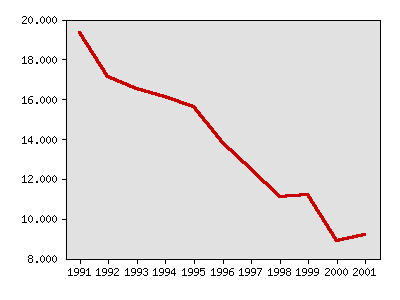What were things like in 2002?
The following idicator summary is from the 2002 Minnesota Milestones and does not neccessarily reflect the current data trends.Indicator : Checkoff campaign contributions
Rationale: Participation in Minnesota's income tax checkoff for contributions to the State Election Campaign Fund is one measure of interest in public financing of campaigns.
About this indicator: Use of the tax form checkoff has decreased by more than half in the last 10 years. Minnesotans may use a checkoff to designate $5 of their state income tax for the State Election Campaign Fund. The checkoff does not affect the taxpayer's tax liability. The fund provides campaign assistance to candidates for legislative and state constitutional offices who voluntarily agree to limit their campaign spending. In 2001, 9.2 percent of income tax filers used the checkoff, compared to 19.3 percent in 1991.
Taxpayers may designate their contribution for a particular political party, but most do not. In the 2000 elections, 98 percent of legislative candidates agreed to spending limits and together received more than $3.2 million from the fund.
Percentage of tax filers who donate $5 to the State Elections Campaign Fund

| Year | Data |
|---|---|
| Percentage of tax filers who donate $5 to the State Elections Campaign Fund, Minnesota Department of Revenue | |
| 1991 | 19.3% |
| 1992 | 17.1% |
| 1993 | 16.5% |
| 1994 | 16.1% |
| 1995 | 15.6% |
| 1996 | 13.8% |
| 1997 | 12.5% |
| 1998 | 11.1% |
| 1999 | 11.2% |
| 2000 | 8.9% |
| 2001 | 9.2% |
For comparison: Only 14 states provide for a state election campaign fund contribution on their state income tax form. Comparative data on participation is not available.
Things to think about: The checkoff is easy and convenient, yet slipping in popularity. At the same time, there has been increased use of the state's political contribution refund program, which provides state-paid refunds to individuals making contributions up to $50 to eligible political parties and state-level candidates who agree to spending limits. This may suggest that citizens prefer to dedicate their political campaign dollars to specific candidates or platforms rather than a general public campaign fund.
Another checkoff option available to Minnesotans is the Nongame Wildlife Fund. The number of taxpayers making contributions through the checkoff has also decreased, but the average donation has increased slightly. A check-off to the Wildlife Fund does increase the filer's tax bill.
Technical notes: Each individual filing an income tax or property tax return may make one $5 checkoff. The data reports the number of checkoffs divided by the number of tax returns for the tax filing year.. Two married taxpayers filing a joint return may each make a checkoff, so the number of individuals filing returns is somewhat larger than the number of returns. As a result, the data somewhat overestimates the percentage of persons choosing to contribute to the fund.
Sources:Minnesota Department of Revenue, Tax Research Division, www.taxes.state.mn.us
Minnesota Campaign Finance and Disclosure Board, www.cfboard.state.mn.us/summary00/entities.html
Related 2002 Milestones indicator:
Other related indicators:
- Public subsidy money dedicated through tax form checkoff, by party or general fund: (Minnesota Campaign Finance and Public Disclosure Board, www.cfboard.state.mn.us/summary00/entities.html)
- Political contribution refunds (Minnesota Department of Revenue, www.taxes.state.mn.us)
Local data:





